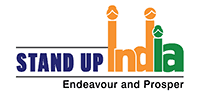Stand-Up India
Stand-Up India was launched by the Government of India on 5 April 2016 to support entrepreneurship among women and SC & ST communities. Stand Up India Loan Scheme is a government initiative launched by the Government of India in 2016 to promote entrepreneurship and facilitate bank loans to Scheduled Caste (SC) / Scheduled Tribe (ST) and women entrepreneurs in the country. The scheme aims to provide loans between Rs.10 lakhs and Rs.1 crore for setting up a greenfield enterprise in manufacturing, trading or services sector.[1]
| Stand-Up India | |
|---|---|
 | |
| Country | India |
| Prime Minister(s) | Narendra Modi |
| Launched | 5 April 2016 |
| Website | www |
It is similar to but distinct from Startup India. Both are enabler and beneficiary of other key Government of India schemes, such as Make in India, Industrial corridor, Dedicated Freight Corridor, Sagarmala, Bharatmala, UDAN-RCS, Digital India, BharatNet and UMANG.
History
Prime Minister Narendra Modi launched the Stand-Up India scheme on 15 April 2016 as part of the government's efforts to support entrepreneurship among women and SC & ST communities.[2]
The scheme
The scheme offers bank loans of between ₹10 lakh (US$13,000) and ₹1 crore (US$130,000) for scheduled castes and scheduled tribes and women setting up new enterprises outside of the farm sector.[3]
Achievement
On the 7th anniversary of the Stand-Up India Scheme, Dr. Bhagwat Kisanrao Karad, the Union Minister of State for Finance, Government of India, highlighted the scheme's significance in promoting financial inclusion. He stated that the scheme aligns with the National Mission for Financial Inclusion's objective of providing funding opportunities to marginalized groups. Over the past seven years, more than 180,000 entrepreneurs have benefited from the scheme. Dr. Karad also expressed satisfaction that a significant proportion of loans granted through this initiative, over 80%, have been directed towards women entrepreneurs. [4]
See also
References
- "About us". Retrieved 8 June 2023.
- "'Stand Up India' will transform lives of Dalits, tribals: Modi", The Hindu, 5 April 2016
- "Modi's Stand Up India scheme will ease pressure on job reservations", Hindustan Times, 6 April 2016
- "More than Rs. 40,700 crore sanctioned to over 1,80,630 accounts under Stand-Up India Scheme in 7 years".